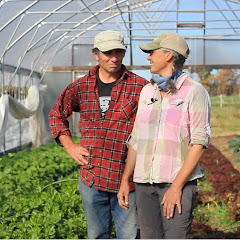Well it is official, the growing season has started. Last Saturday February 4th our two new interns, Dani Hurst and Ryan Stubby, joined us for half a day to initiate the planting of over 12,000 onion seeds. We finished up the planting yesterday with Luke, and will concentrate on tending to your vegetables for the next 10 months.
 |
| Planting the first seed of 2012 |
 |
| Dani making soil blocks |
 |
| Ryan and Rebecca seeding onions |
Along with the seeding, we have been taking advantage of the warm weather to do as much equipment maintenance as possible this year. We are hoping it pays off during the growing season by minimizing equipment breakdowns, delays, and frustrations, while improving the working life and safety of our machinery.
One piece of equipment we worked on is the spader. For a while now the frame/shroud that surrounds the digging spades has been bent and in need of some adjustment. With a lot of elbow grease from Luke we were able to take the frame apart so that we could work on it.
Local artist/metal worker/handy guy Jeff Becker came up with the solution to bending things back into shape...run over it with the tractor! Well, in true Missouri farmer fashion we used the tools and leverage we had at hand and were able to straighten things out. Re-assembly is on its way.
 |
| Spader with bent rake frame |
 |
| Straightening the frame |
This winter season we have seen a lot of birds on the move, more it seems than the last couple years. A huge flock of snow geese flew over the greenhouse on Monday, It was quite a sight and sound. If I had the time I would count the number of birds in the photo out of curiosity.
 |
| Snow geese on the move |
Lastly, a salami update. For the past several years we have been working on perfecting the making of an annual batch of Finocchiana, a peppercorn and fennel seed flavored cured pork salami. The recipes we have used has been consistently good, and when we can get 20 lbs of Parker Farms pork shoulder, the meat quality is the best. The trick has always been the curing process.
To make a tasty (and safe) salami you need to cure it at the proper temperature and humidity. In the past we relied on whatever conditions a cool basement could provide. Then we started curing it in a box of wood ash from our stove. With the construction of our "cave" in the lower part of the barn we are able to control the temp and humidity to the general levels required.
The results have been the most consistent batch of salami yet. Thank you local hogs.
 |
| 2012 Finocchiana |























